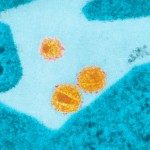Lien vers Pubmed [PMID] – 9680144
J. Gen. Virol. 1998 Jul;79 ( Pt 7):1793-9
Human immunodeficiency virus type 2 (HIV-2) strains that infect cells in the absence of cellular CD4 emerge spontaneously in vitro after culture in CD4+ T-cell lines. The HIV-2ROD/B strain can use the CXCR4 chemokine receptor for efficient entry into CD4+ cells. Here we have shown that the rat homologue of CXCR4, in the absence of CD4, failed to mediate CD4-independent entry by ROD/B. Furthermore, using rat-human chimeric CXCR4 receptors we have demonstrated that the second extracellular loop (E2) of human CXCR4 is critical for HIV-2 infection of CD4+ cells. E2 is also important for HIV-1 infection of CD4+ cells. Our results therefore indicate that the role of E2 in HIV entry is conserved for HIV-1 and HIV-2 and for infection in the presence or absence of CD4.

